Sword - as a symbol of the Middle Ages
O Durendal damask, my bright sword,
In whose handle of the shrine I have finished the old:
In it is Vasily's blood, Peter's imperishable tooth,
Vlas of Denis, the man of God,
Piece of Mary’s Rebenz Reza.
("Song of Roland")
The sword for the Middle Ages is clearly more than a simple weapon. For the Middle Ages, it is primarily a symbol. Moreover, in its capacity as such, it is still used in military ceremonies in various armies on the globe, and he does not even try to challenge this role with any other weapon. Most likely, it will be so in the future, because it was not for nothing that the creator of Star Wars, George Lucas, made all-powerful Jedi’s weapon with a ray sword and explained this by saying that he needed weapons worthy of knights who would be honest, and who would fight for peace in the entire galaxy. However, the fact that he decided so is not surprising. After all, the sword at the same time symbolizes the cross, and the cross is nothing more than a symbol of the Christian faith.
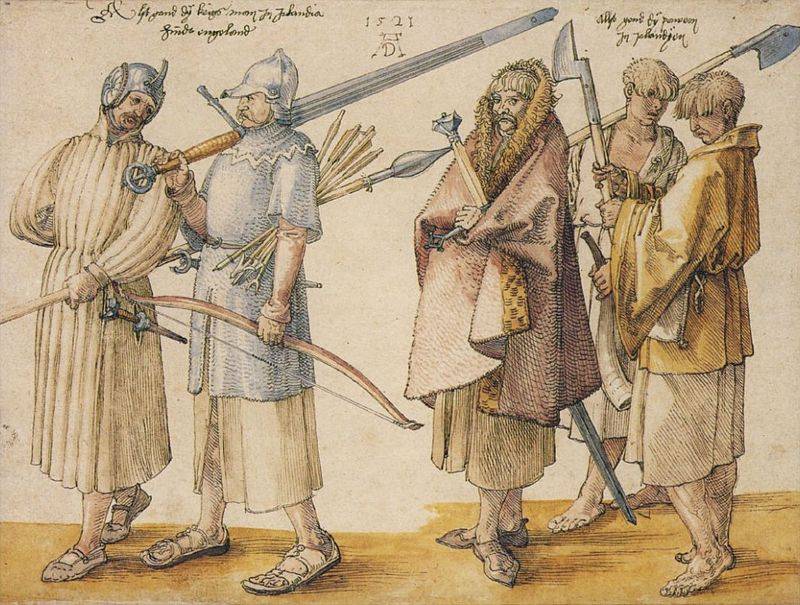
Figure of Albrecht Dürer 1521 of the year, depicting Irish mercenaries in the Lower Lands. One of the two two-handed swords shown here has a ring-shaped ridge, characteristic only for Irish swords.
Of course, many Christians of the 21st century may feel uneasy from such a comparison, but a clear tendency to war and violence occurs to us not only in the Old, but also in the New Testament, where the name of absolute peacemaker Jesus says the following: “Do not think that I came to bring peace to the earth; I did not come to bring peace, but a sword. ” (Matthew 10, 34)
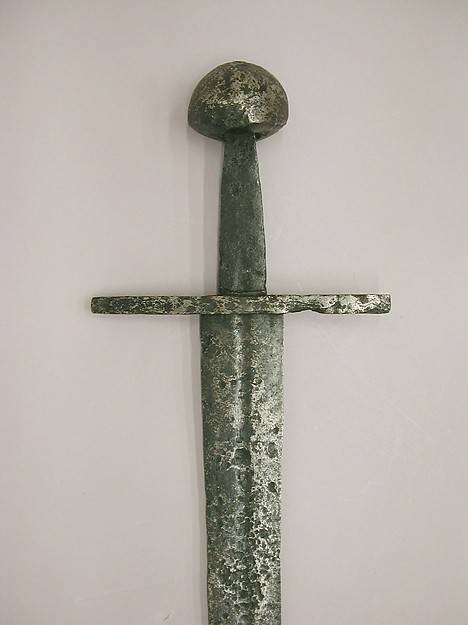
Sword XII - XIII centuries. Length 95,9, see Weight 1158 (Metropolitan Museum, New York)
Theologians may argue about what these words mean, but the word “sword” in this phrase will not go anywhere. Moreover, already in the early Middle Ages, the military leader was different from the simple warrior that possessed a sword as a weapon, while those had axes and spears. When in the Middle and Late Middle Ages simple warriors began to possess swords, the sword became a symbol of Christian chivalry.
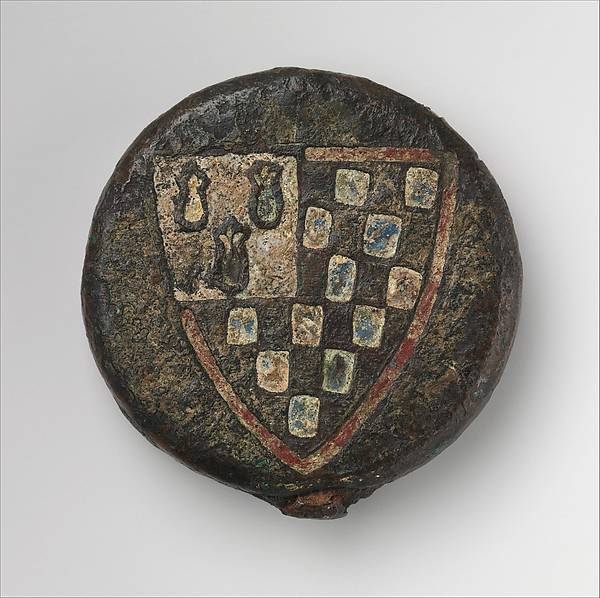
Pinnacle with the coat of arms of Pierre de Dre, Duke of Brittany and Count Richmond 1240 - 1250 Weight 226.8 (Metropolitan Museum, New York)
The knight has been trained to wield weapons since childhood. At the age of seven, he had to leave the parental shelter and move to the court of some friendly lady-knight to serve there as a page to his lady and in that capacity and undergo his training. While learning the numerous skills of a servant, the page simultaneously learned and fought on wooden swords. In 13 years he became a squire and could take part in battles. After that, another six or seven years passed and the training was considered complete. Now the squire could become a knight or serve as a “noble squire”. At the same time, the squire and knight differed very slightly: he had the same armor as a knight, but he did not wear a sword (because he did not solemnly girded it!) Not on his belt, he attached the saddle to the bow. In order for the squire to become a knight, he had to dedicate and gird his sword. It was only then that he could wear it on his belt.
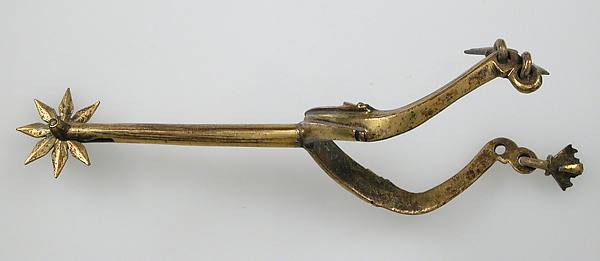
Spurs were also a symbol of chivalry. At first they girdled with a sword, then they tied spurs to their legs. These are the spurs of the 15th century French knight. (Metropolitan Museum, New York)
So what exactly the presence of the sword, even if it was even at the saddle, in the Middle Ages was a clear difference between a free man of noble origin and a commoner or worse - a serv.
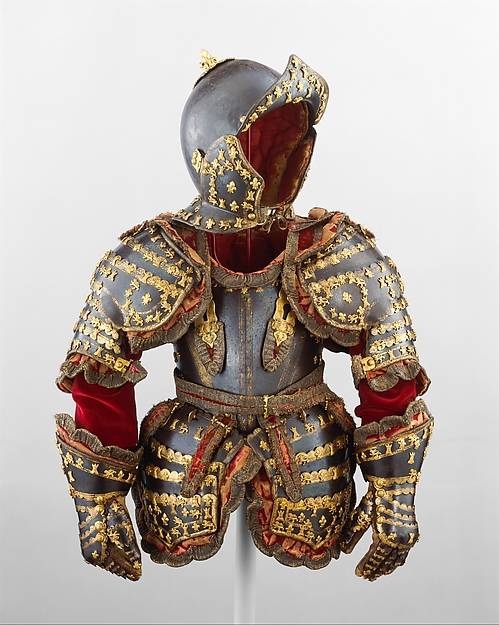
Already in the armor, no one fought, but they continued by tradition to do ... for children and youth! Before us is the armor of the young infanta Louis, Prince of Asturias (1707 - 1724). (Metropolitan Museum, New York)
Well, of course, it is not by chance that the knight’s sword, if you look at it full face, it looked like a Christian cross. The bows at the cross were turned down only from the XV century. Before that, the arms of the cross were exclusively straight, although there were no specific functional reasons for this. It was not for nothing that in the Middle Ages the cross at the sword was called a cross (whereas the Muslim saber corresponded to the curvature of the crescent). That is, this weapon was consciously equated with the Christian creed. Before handing the sword to the candidate of the knights, he was kept in the altar of the chapel, thus clearing from all evil, and the sword itself was handed over for the presentation of the priest in charge.
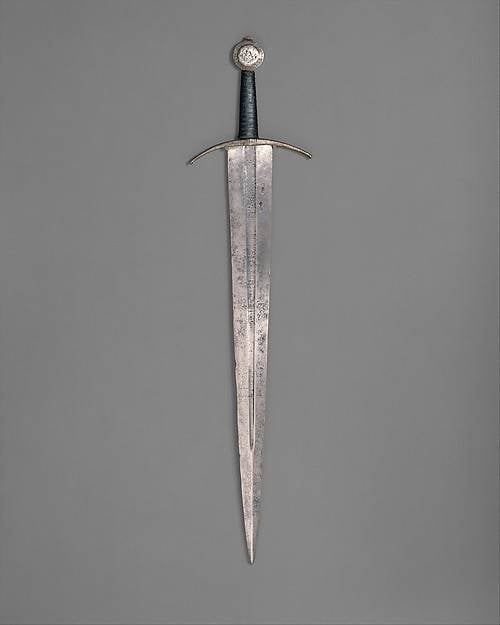
Sword 1400 of the year. Western Europe. Weight 1673 d. Length 102.24 cm. (Metropolitan Museum, New York)
Well, all commoners and serfs usually have swords and it was forbidden to carry them. True, this situation has changed somewhat in the era of the late Middle Ages, when free citizens of free cities, among other privileges, acquired the right to bear arms. The sword now also became the honors of the free citizen. But if a knight learned how to use a sword from childhood, then ... the city dweller had the opportunity to do this by no means always, which eventually led to the flourishing of the art of fencing with swords.
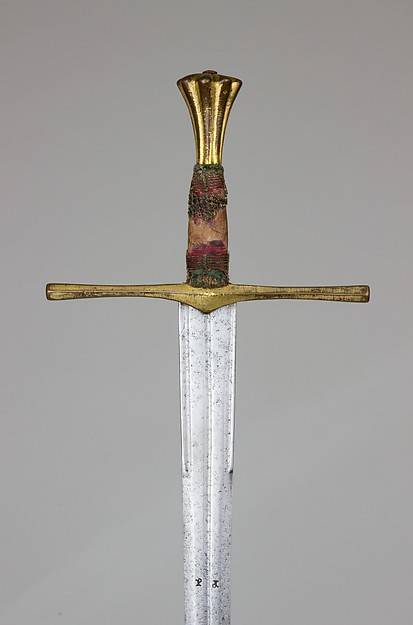
Sword of the 16th century Italy. Weight 1332.4 (Metropolitan Museum, New York)
Naturally, the status of the sword was in a number of circumstances. So, come down to us historical documents say that even a medium-quality sword was equal to the value of at least four cows. For an agrarian peasant society, such a price was equal to a fortune. Well, high-quality swords could cost even more. That is, if you compare the sword with other types of weapons, for example, a battle ax, battle flail or halberd, then among them it was the most expensive. In addition, swords were often richly decorated that their business is even more expensive. For example, it is known that Charles the Great had both the hilt of his sword and the band to it were made of gold and silver. "Sometimes he wore a sword adorned with precious stones, but this usually happened only on particularly solemn occasions or when embassies of other nations were presented to him."
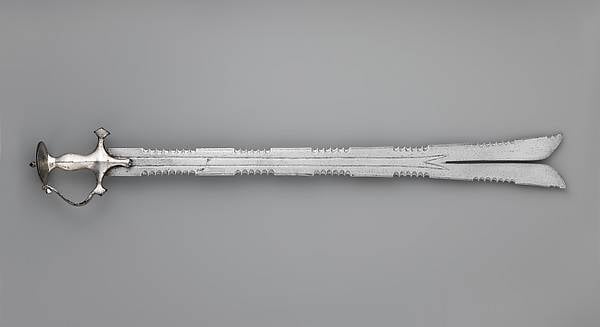
And this is a completely unique Indian sword of the XVIII century. (Metropolitan Museum, New York)
However, the decoration of the sword in the early Middle Ages was never lush - because the sword was a functional thing, especially when compared with the weapons of the Renaissance, which was overloaded with all sorts of decorations. Even the royal swords, although they had gilded handles, and their blades were engraved, were usually quite modest and generally practical, very well-balanced weapons of high quality. That is, the kings of these swords could really fight.
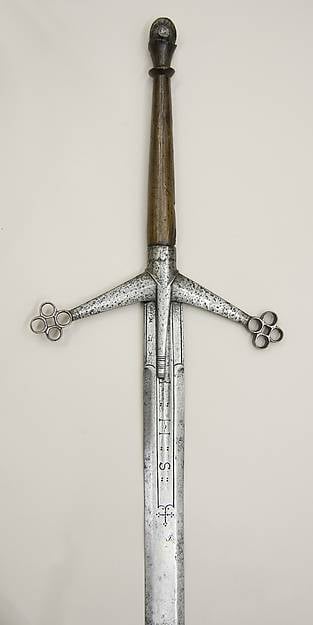
Claymore 1610 - 1620's. Length 136, see Weight 2068.5 (Metropolitan Museum, New York)
It happened that the knights, and even more so the kings owned several swords at once. So, Charlemagne had special swords purely for representation and less decorated for everyday use. In the late Middle Ages, warriors often had one sword with a hilt in one hand and one long battle sword in one and a half hands. Already the manuscripts of the 9th century note that the margrave Eberhard von Friol had as many as nine swords, and a certain Anglo-Saxon prince of the 11th century had a whole dozen swords, which according to his will after his death were divided among all his sons.
In addition to the function of social status, the sword was also a sign of administrative authority. For example, in the collection of feudal law of the XIII century "Saxon mirror" there is an image in which the king receives the sword of worldly power from Jesus, while the pope is awarded the sword of spiritual power. Both at the knighting ceremony and at the coronation of the king or emperor, the sword, together with the crown and scepter, was considered to be exactly the same symbol of supreme power. For example, the holy Mauritius - the imperial sword of the Holy Roman Empire of the German nation, the German kings were girded by the pope.
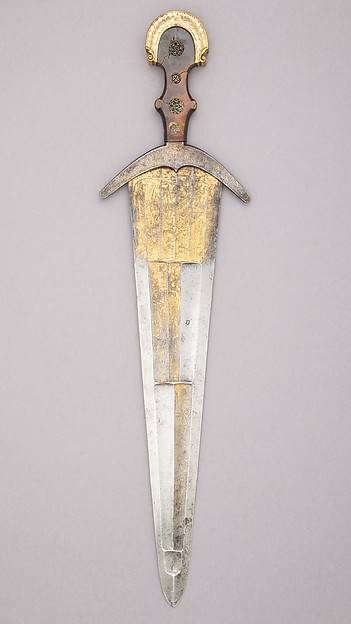
Cinquedea 1500 Italy. Weight 907 (Metropolitan Museum, New York)
When the king left the church, his sword in front of him was carried out by a special sword, as a sign of his secular power and power, with the tip pointing upwards. Therefore, the position of the royal swordtail throughout the Middle Ages was revered as one of the most honorable.
Already in the XIV century, the city burgomaster and judges received special ceremonial swords, and they, too, as a sign of the high power of their owners, were brought before them. Usually they were luxuriously finished bastard swords or very large two-handed swords. One such sword has reached us - the “official sword” of the city of Dublin. Its gilded handle has a characteristic faceted pear-shaped head and a long crosshair. Moreover, the history of this sword is known exactly: in the 1396 year it was made for the future king Henry IV. And, apparently, the king used it, since there are notches and other characteristic traces of military use on his blade.
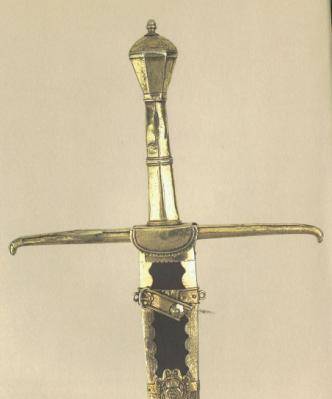
The City Sword of Dublin symbolizes the administrative authority of the city mayor.
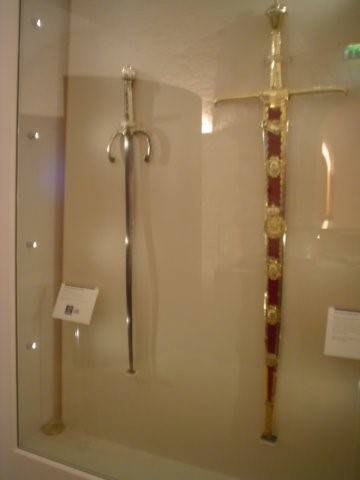
And so this sword looks in all its glory. The sheath, however, made much later. (Museum of Dublin, Ireland)
But there were very special swords, called "swords of justice." Naturally, this is not a combat weapon and, of course, not a status weapon. But the "sword of justice" was very important, because in the Middle Ages, the usual beheading was carried out with an ax, but with such a sword they cut heads to nobles. In addition to demonstrating social differences, there was a very obvious practical reason: the one who was executed with a sword experienced less suffering. But since the 16th century, in the German cities, criminals from the burgher class also began to be beheaded more and more often with a sword. A special type of sword was created specifically for the butchers' needs. It is believed that one of the first such swords was made in Germany in 1640 year. But most of the surviving swords of justice date back to the 17th century, and at the beginning of the 19th century they were no longer used. The last fact of using such a sword in Germany took place in the 1893 year: then with its help a female poisoner was beheaded.
1688 executioner's sword of the year. The city museum of Rotval, Baden-Württemberg, Germany.
It is interesting (as far as this can be interesting at all!) That the execution with a sword requires the use of a completely different technique than the execution with an ax. There, the convicted person should put his head and shoulders on the block - a scene very clearly shown in the remarkable Soviet movie “Cain XVIII” (1963), after which the executioner chopped down with a broad-blade ax, after having thrown back or cut off the victim's long hair. But when the head was cut with a sword, the condemned one had to kneel, and the chopping block was not required. The executioner took the sword with two hands, waving his arm wide and applied a horizontal chopping blow from the shoulder, which at once carried the person off his shoulders.
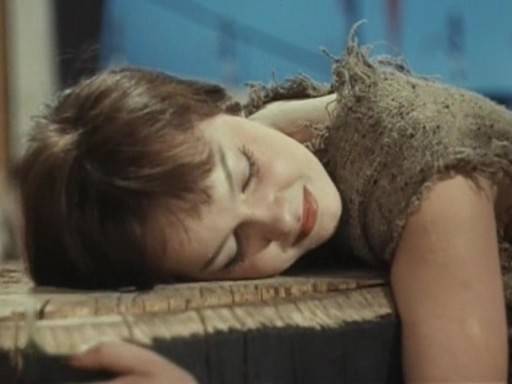
So it was necessary to lay his head on the scaffold, so that the executioner chopped it off with an ax. A shot from the film "Cain XVIII".
In England, for some reason, the “sword of justice” never took root, and there people were beheaded with an ordinary ax. But still there were executions, albeit few, that were carried out with a sword, which was vivid evidence of the significance of both the event, the instrument, and the skill that was required for this. When, for example, King Henry VIII in 1536 decided to execute his second wife Anna Bolein, then ... she was beheaded with a sword. Especially for this called the executioner from Saint-Omer under Calais. He beheaded Anna Boleyn with just one masterful punch.
About how important the specialist was to ensure the painlessness of the death of the executed one, clearly shows the case that took place in France in 1626 year: then an inexperienced volunteer played the role of executioner. So he needed as many 29 (!) Times to strike with a sword to cut off the head of Count de Chalet. And on the contrary, in 1601, the professional executioner managed to decapitate two convicts at once with just one blow, tying them back to back.
"Swords of justice", as a rule, had two-handed handles and simple and straight bow crosses. They did not need the edge, so they do not have it. So the blade is like a screwdriver. Usually, the blades of swords of justice are very wide (from 6 to 7 centimeters), and their total length most closely matches the bastard sword. Weigh such swords from 1,7 to 2,3 kilograms, have a length of 900-1200 mm. That is, it is a cross between a bastard sword and an ordinary heavy two-handed sword.
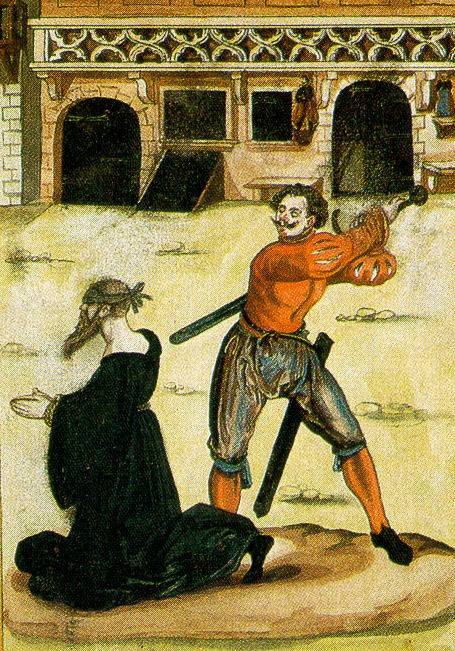
And so it was cut off with a sword. Scene penalty 1572 year.
The blades often depicted symbols of justice and all sorts of instructive sayings like: "Fear God and love the right, and the angel will be your servant." One of the swords of justice by the work of the master Zolingen Johannes Boigel, made by him in 1576, has the following verse inscription on the blades:
“If you live virtuously.
Do not chop the sword of justice of your head. ”
"When I raise this sword,
I wish that to the poor sinner eternal life! ”

Information